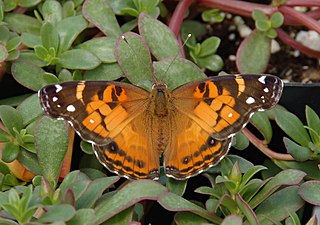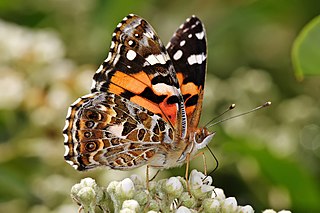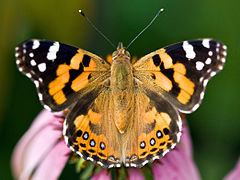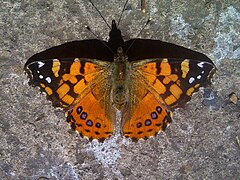
The West Coast lady is one of three North American species of brush-footed butterflies known colloquially as the "painted ladies". V. annabella occurs throughout much of the western US and southwestern Canada. The other two species are the cosmopolitan Vanessa cardui and the eastern Vanessa virginiensis. This species has also been considered a subspecies of the South American Vanessa carye and is frequently misspelled as "anabella".

Vanessa cardui is the most widespread of all butterfly species. It is commonly called the painted lady, or formerly in North America the cosmopolitan.

Mycalesis oculus, the red-disc bushbrown, is a satyrine butterfly found in southern India. It is similar in markings to Mycalesis adolphei but distinguished by the reddish band around the large apical spots on the upper forewings.

Vanessa is a genus of brush-footed butterflies in the tribe Nymphalini. It has a near-global distribution and includes conspicuous species such as the red admirals, the Kamehameha, and the painted ladies of the Cynthia group : Painted lady, American painted lady, West Coast lady, Australian painted lady, etc. For African admirals, see genus Antanartia. Recently, several members traditionally considered to be in the genus Antanartia have been determined to belong within the genus Vanessa.

Libythea lepita, the common beak, is a butterfly that belongs to the Libytheinae group of the brush-footed butterflies family. It is found from southern India to Japan and its larval food plants include members of the Cannabaceae, particularly in the genera Celtis and Trema.

Apatura ilia, the lesser purple emperor, is a species of butterfly native to most of Europe and east across the Palearctic. It is named for its similarity to the purple emperor butterfly.

The American painted lady or American lady is a butterfly found throughout North America.

The Australian painted lady is a species of butterfly mostly confined to Australia, although westerly winds have dispersed it to islands east of Australia, including New Zealand. Debate surrounds the taxonomy of this species. Some believe that the Australian painted lady should be a subspecies of the painted lady due to the similarity in lifestyle and behaviour. Furthermore, the painted lady is found around the globe, but Australia is the only location in which it varies enough to be considered a separate species.
Painted ladies, in the U.S., are Victorian houses repainted in bright polychrome

Morpho deidamia, the Deidamia morpho, is a Neotropical butterfly. It is found in Panama, Nicaragua, Costa Rica, Suriname, Bolivia, Venezuela, Colombia, Peru, Ecuador, and Brazil. It is a species group, which may be, or may not be several species. Many subspecies have been described.

Libythea celtis, the European beak or nettle-tree butterfly, is a butterfly of the Libytheinae group of the brush-footed butterflies family.

Hippotion velox, the dark striated hawkmoth, is a species of sphingid moth or the family Sphingidae. The species was described by Johan Christian Fabricius in 1793.

Acraea cepheus, the Cepheus acraea, is a butterfly of the family Nymphalidae. It is found in Africa, from Nigeria and Angola to Uganda, western Tanzania and Zambia.

Acraea natalica, the Natal acraea, is a butterfly of the family Nymphalidae, which is native to East and southern Africa.

Acraea oncaea, the window acraea, is a butterfly of the family Nymphalidae. It is found in KwaZulu-Natal, Transvaal, Zimbabwe, Mozambique, from eastern Africa to Abyssinia and in Congo.

Acraea zetes, the large spotted acraea, is a butterfly in the family Nymphalidae which is native to sub-Saharan Africa.

Euphaedra cyparissa, the true forester, is a butterfly in the family Nymphalidae. It is found in Guinea, Sierra Leone, Liberia, Ivory Coast, Ghana, Nigeria, Cameroon, the Central African Republic and the Democratic Republic of the Congo. The habitat consists of drier forests and open wet forests or the edges of wet forests.

Euphaedra eleus, the Eleus orange forester, is a butterfly in the family Nymphalidae. It is found in Guinea, Sierra Leone, Liberia, Ivory Coast, Ghana, Nigeria, Cameroon, Gabon, the Republic of the Congo, Angola, the Democratic Republic of the Congo and Uganda. The habitat consists of primary forests and secondary forests with a closed canopy.

Vanessa carye, the western painted lady, is a butterfly of the family Nymphalidae. It is found in South America, from the mountains of Colombia and west of Caracas (Venezuela) through Ecuador, Peru, Bolivia, Chile, southern Brazil, and Paraguay to Patagonia in Argentina. It is also found on Easter Island and Tuamotus.

Erebia rossii, the Arctic alpine or Ross's alpine, is a member of the subfamily Satyrinae of the family Nymphalidae. It is found in Arctic North America and northern Eurasia.





























